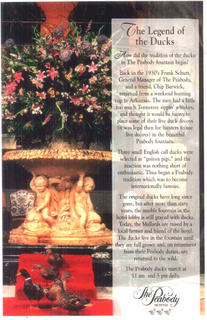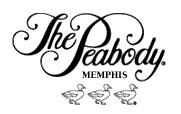TTAB Says Peabody Hotels' 182-Word Duck "Legend" Does Not Function As A Mark
You might say that the Peabody Hotels laid an egg in their attempt to register the alleged mark set out in the paragraph below, comprised of 182 words (for convenience, referred to as "THE LEGEND"), for hotel and facilities services. Or you might say that the TTAB filled the egg-laying role. In any case, the Board found that "the matter sought to be registered does not function as a service mark for the services identified in the application." In re Peabody Management, Inc., Serial No. 76068295 (June 30, 2005) [not citable].
THE LEGEND OF THE DUCKS. HOW DID THE DUCKS IN THE PEABODY FOUNTAIN BEGIN? BACK IN THE 1930'S FRANK SHUTT, GENERAL MANAGER OF THE PEABODY, AND A FRIEND, CHIP BARWICK, RETURNED FROM A WEEKEND HUNTING TRIP TO ARKANSAS. THE MEN HAD A LITTLE TOO MUCH TENNESSEE SIPPIN' WHISKEY, AND THOUGHT IT WOULD BE FUNNY TO PLACE SOME OF THEIR LIVE DUCK DECOYS (IT WAS LEGAL THEN FOR HUNTERS TO USE LIVE DECOYS) IN THE BEAUTIFUL PEABODY FOUNTAIN. THREE SMALL ENGLISH CALL DUCKS WERE SELECTED AS "GUINEA PIGS", AND THE REACTION WAS NOTHING SHORT OF ENTHUSIASTIC. THUS BEGAN A PEABODY TRADITION WHICH WAS TO BECOME INTERNATIONALLY FAMOUS. THE ORIGINAL DUCKS HAVE LONG SINCE GONE, BUT AFTER MORE THAN 60 YEARS, THE MARBLE FOUNTAIN IN THE HOTEL LOBBY IS STILL GRACED WITH DUCKS. TODAY, THE MALLARDS ARE RAISED BY A LOCAL FARMER AND FRIEND OF THE HOTEL. THE DUCKS LIVE IN THE FOUNTAIN UNTIL THEY ARE FULL GROWN AND, ON RETIREMENT FROM THEIR PEABODY DUTIES, ARE RETURNED TO THE WILD. THE PEABODY DUCKS MARCH AT 11:00 AM AND 5:00 PM DAILY.
Applicant Peabody claimed that its hotels are "famous for the Peabody Duck March" -- a parade of ducks that march into the hotel lobby in the morning, and depart the lobby in the evening, all to "great fanfare." This gimmick has, according to Peabody, "become a part of the Hotel lore itself" and the applied-for mark must be considered in that context. Peabody acutely recognized that its proposed mark is "not a traditional one," but asserted that it is "no different than a variety of nontraditional marks that have been registered." Three identically-worded customer declarations attested to the source-identifying function of THE LEGEND.
Peabody pointed out that the THE LEGEND appears on brochures, napkins (in abbreviated form), and other promotional and ancillary materials, and on the hotels' website. Thus, it argued, THE LEGEND functions as a service mark for the identified services.

The Examining Attorney contended that the length of the alleged mark is a factor to be considered: a longer collection of words is more likely a proper subject for a copyright, and not a trademark. Peabody, she argued, "is using the 182 words as a story about its hotels, and not as a service mark for its services."
The Board framed the question thusly: "Would THE LEGEND mark sought to be registered be perceived as a source indicator or merely an informational story?" It agreed with the Examining Attorney that the length of the proposed mark is a factor to be considered. But in any case, the Board concluded, "[a]s used by applicant, THE LEGEND simply would not be viewed as a service mark for applicant's services."
"applicant's specimen does not show use of THE LEGEND to identify the services for which applicant seeks registration; to the contrary, THE LEGEND conveys history and current information in the nature of an advertisement for the Duck March. We particularly note that THE LEGEND even sets forth the time of day of the Duck March ('11:00 AM and 5:00 PM DAILY')."
The three customer declarations submitted by Peabody caused the Board to pause briefly in its march to affirmance of the refusal to register:
"We are not persuaded by the declarations to reach a different result. What the declarations do tend to suggest is that at least three individuals recognize THE LEGEND and associate it with applicant. Although THE LEGEND may be associated with applicant's hotel, we cannot conclude, based on the present record, that the matter sought to be registered functions as a service mark."
The Board dubiously relied on In re Deister Concentrator Co., 129 USPQ 314, 320 (CCPA 1961), for the proposition that "not everything that enables one to determine source is a trademark. *** [n]ot everything that enables goods to be distinguished will be protected as a trademark." Applying that sweeping statement, the Board swept aside the declarations, pointing out that Applicant's designation, to qualify as a registrable trademark, must be used as a mark: "Given the nature of how THE LEGEND is actually used, some level of recognition by only three individuals is hardly sufficient to make unregistrable matter into a service mark."

TTABlog comment:The Board's reliance on Deister here is highly questionable. Deister concerned the registrability of a product configuration: namely, the rhomboidal outline of the working surface of an ore concentrating and coal cleaning table. The CCPA ruled that, because the shape was functional, it could not be registered as a trademark, regardless of whether it had acquired de facto secondary meaning. It was in that context that the CCPA broadly stated that "A trademark distinguishes one man's goods from the goods of others; but not everything that enables goods to be so distinguished will be protected as a trademark."

Not only is the CCPA’s broad statement in Deister mere dictum, but the facts in Deister are wholly different from those involving THE LEGEND. A de jure functional product shape can never be a trademark, but a 182-word slogan could be, if used properly. Thus Deister has no relevance to the instant case. In the context of evaluating whether THE LEGEND is perceived by customers as a trademark, the three customer declarations merit consideration -- much more consideration that the backhanded attention accorded by the Board.
As to Peabody's evidence of secondary meaning, what if, instead of three customer declarations, Peabody had submitted survey evidence regarding source identification? Would the Board still have concluded that THE LEGEND is not a service mark? What if Peabody had put THE LEGEND on towels, sheet, pillowcases, ashtrays, t-shirts, matchbooks, etc.? Would that have satisfied the Board that THE LEGEND was being used as a mark?
Text Copyright John L. Welch 2005. All Rights Reserved.




0 Comments:
Post a Comment
<< Home